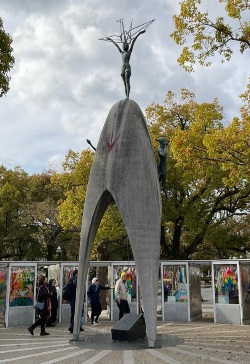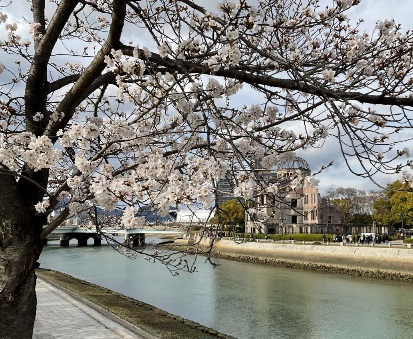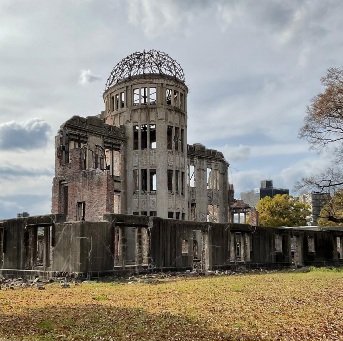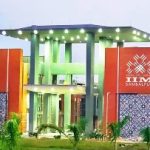By Trilokya Jena
No visit to Japan is complete without a tryst with history in this melancholic city.

Hiroshima is one of the most educational and emotionally gripping travel experiences for any traveller. Only a very ignorant and insensitive traveller can leave this place without shivers down his/her spine. It’s a city where silence reigns.Hiroshima means ‘broad island’, generally flat and roughly circular in shape with six channels of river Ota dividing it to several islets. The Chugoku mountains surround most part of the city with Seto Inland Sea forming its southern boundary.
Historically this city has been prosperous due to the fertile river delta and the sea offering access to various islands and the outside world. It has been a castle town since the Shogun period later converted to military headquarters and academy with the Meiji takeover.
It’s almost impossible to utter the name Hiroshima without evoking the single horrific image of utter destruction and death. Everyone knows that here on a beautiful clear morning almost eight decades ago on August 6, 1945 precisely at 8.15 hrs an atomic bomb was dropped for the first time, followed three days later in Nagasaki, to end World War II. The question then is why Hiroshima? Answers to that are many, but I’ll go for the Japanese version. Japanese believe in four major reasons for choosing Hiroshima over others seemingly more important places.
The first concerned geographical location as Hiroshima is a compact city surrounded by mountains that’d offer a more concentrated effect of the bomb when its efficacy was not clearly known. Second was military as the city contained key war establishments including the military academy. The third was it provided crucial naval connections to areas in and out of Japan from its naturally protected shores crucial for both military and commercial purposes. The fourth being the perception that there were no allied forces, read Americans, held as PoW in the city. Besides, it was generally believed that Hiroshima situated on the inner side of Pacific Ocean towards mainland Asia and mountain all around didn’t require much air defence cover as Tokyo, Kyoto or Osaka.
I had a special connection with Hiroshima since my childhood which got strengthened later when I met some Japanese PhD students Sui dying in the National Library, Kolkata. I started my emotional growth in early 1960s with our war with China and was very fortunate to be given a wonderful book of world history by my school teacher that exposed me first to the Second World War and the American bombing of Hiroshima and Nagasaki. This singular ill fate of an Asian country and other contemporary developments around me led to an emotional bonding with the Japanese.
At the time I was growing up in a village on the outskirts of Cuttack, now a fast developing suburb, a deep relationship with Japan was being scripted by Nehru. It was decided to export iron ore from Odisha to the mineral starved Japan for its burgeoning steel industry. As roads and rail connectivity were not in place at the time, the water channel of Taladanda canal was only option to ferry ores to the freshly established port of Paradeep. My village home where I often stay stands on the bank ok that canal. Till the time I joined College and moved to the city, the sight of ferry after ferry sailing down the canal carrying sizeable dump of faded red hematite iron ore was my abiding image of childhood. I was told by elders that Japan was rebuilding itself out of war ruins including the destroyed Hiroshima. And that remained in me as an emotional connect with the city and the country of Japan.Later in my student life I came to know more and more about the world and got to understand the progress of civilisation, history of nations, their rivalries and conflicts including the complexities of international relations.

Apart from history and literature, it was cinema that helped me to gain greater insights into the Japanese society and culture. Japan was the first Asian and Oriental nation to etch out its place at par with the West in cinema with Ozu and Kurosawa emerging as world class filmmakers. I was fortunate to get exposed to world cinema as an undergraduate, thanks to my friends from Calcutta. It was then that in a Film Society screening I got to watch Alan Resnais’ 1958 film Hiroshima Mon Amour. Though it was too emotionally complex a film for me to fully comprehend as a teenager, the visuals of the city and the characters’ emotional turmoil created lasting impressions. Today, my emotional impression of Hiroshima is influenced by two more films, Clint Eastwood’s poly-.perspective Japan duo-logy, Flags of Our Fathers/Letters From Iow Jima(2006) and Christopher Nolan’s Oppenheimer(2023).
We took the bullet train from Kyoto to Hiroshima, a one and half hour’s journey with Japanese precision. From Hiroshima station we were picked up by our Japanese guide into a bus that carried us to the ferry terminal of Miyajima. We took the ferry to the Itsukuhima Shrine sailing past the iconic floating Torii Gate into the island. The island signifies the Japanese meaning of Miyajima that is ‘shrine island’. The entire island is considered sacred for Shinto followers, Shintoism being the ancient faith of Japanese prior to entry of Buddhism. Its followers worship nature and ancestors and consider the entire island as a human body not to be violated. After this visit to the island, its thousand gates and hill of deities we were sufficiently somber for the journey to Hiroshima city and its ground zero.Drive through the city across many bridges over its water channel was smooth but somber. The entire city has been rebuilt beautifully, clean, pristine and safe today. Life here is easy paced and unhurried unlike bustling commercial hubs of Tokyo or Osaka. There are very limited high rises but neat buildings line one side of the water channel while there is greenery on the other. There are lines of Cherry blossom in full bloom align side the streets and on banks of water channel. The city looks beautiful but few are visible on the roads. I was told that much of the activities involving malls, stores, general markets and eateries are located underground. The city is perhaps shy of life in the open.
The central site of the city is the famous heritage site of the A-Bomb Dome, also called Genbaku Dome, signature part of the sprawling Hiroshima Peace Memorial Park. The skeleton of the building miraculously survived unlike other structures and its skeletal remains the only structure standing from the devastation of the bombing standing as the central monument to the 140, 000 people, almost all civilians who perished.
There are various other shrines in the Peace Park among which is the Children Peace Monument, built in the memory of a school girl who miraculously survived initially but succumbed later to leukaemia. It stands out with a little girl with her hands stretched out for peace to the world and a boy right on top of the monument. The monument contains a bell of peace which is rung by visitors with sorrow over the past and hope for the future.The background of the Peace Monument contains a colourful wall hangings made out of thousands of paper cranes. This connection between paper cranes and peace can be traced back to a young girl named Sadako Sasaki, who died of leukemia ten years after the atomic bombing. Believing that folding paper cranes would help her recover, she kept folding them to her end. Initially her friends raised contributions to commemorate her struggle which triggered a campaign to build a monument to pray for world peace and the peaceful repose of the many children killed by the atomic bomb.
The Children’s Peace Monument was built with funds donated from all over Japan. Created through the Japanese art of Origami it has become a movement for everyone to add a crane in the memory of Sadako as a symbol of peace.Then there is an ever burning flame of peace, a flame placed on a pedestal sorrounded by water burning continuously since it was lit on August 1, 1964. It will continue to burn until there’d be no nuclear weapons left on earth. You’d find the central slogan of Hiroshima “No More Hiroshima “.
At the centre of the Park you’ve a curvy structure known as the Cenotaph where flowers are placed per for the bomb victims. Through the curve of the Cenotaph there is a clear view of the Dome as a sinister reminder. At the rear end of the Park stands the impressive building of Peace Museum built in 1955. The Museum elaborately displays images of Hiroshima before and after the bombing, articles remnants after the bombing including the melted pieces of heavy metals, all kinds of belongings left of the victims. There are sections running films of simulations of the horrific event and collections of all kinds of items that display grief, anger and pain of people. Finally at the exit of the Museum there is the Peace Watch that keeps ticking displaying at the top the number of days since the first dropping of the A-bomb and below it the number of days since the latest nuclear test. The visit to the Museum brought many shots from Resnais’ film which I shall discuss in Part II.Our Japanese guide was a lady in her early sixties belonging to a family of bomb victims. Her demeanour was lugubrious but she spoke good English and her impression of the city with knowledge of the holocaust was impressive. The melancholic air she carried was perfect reflection of the place and her job. I found some space with her during the visit and asked her what has she been told by her parents. Her reply was that she’s going to narrate it to the entire group later. I asked her if I could video-graph when she narrates to which she in her Japanese politeness didn’t say no. But I could detect tinges of resignation, sadness and hesitation in her that dissuaded me not to video-graph.
On our journey back to Hiroshima station she narrated her story in her stoic style. Her mother, who passed away recently, barely survived as the place where she lived was just outside the periphery of the worst effect of the bomb. She grew up through public care system in the aftermath of the holocaust and rebuilt her life much the same way the city was rebuilt. She never talked much about the incident nor of life before. It was easy to understand where our guide got her stoic nature from. She never spoke about her father nor about her personal status. She recounted one thing her mother said to her.
Soon after the bombing the Americans showered a lot of concern and care over the destroyed city. Strong medical teams were sent which took care of the sufferings of the survivors who developed all kinds of diseases. Every one was so happy and thankful of those Americans. However, it appeared that most of these medical care was not curative but experiments carried out by the Americans to study the effect of atom bomb. Such revelation led to her mother to disillusionment and silence, something that became a trait for most survivors. The general impression she gave was that those who died instantly were the lucky ones. They didn’t have to die every moment for a long time. No body had the heart to ask our guide about her personal life. In her own ways she so completely symbolised the city and its spirit of civility, composure and competence. And at the same time spreading melancholy and silence. When she parted company with us at the station she did that with utmost courtesy and dignity.
The Japanese are very proud people extremely conscious of their duty and obligation. They possess the highest degree of self respect and would never seek a favour that is not their due. Tipping is not an acceptable practice in Japan. Walking towards the bus stand she represented the past and present of Hiroshima. I felt sorry for myself for I had my hands in the pocket to take out a few bucks as reflex action in these situations. Back on the train to Kyoto I realised it was my most cathartic travel experience ever.
(Jena is former Principal Chief Commissioner of Income Tax. He has just returned from a tour of Japan)






